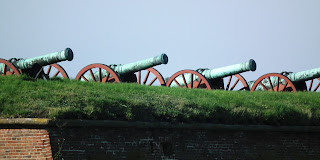 |
| Øresund in a map by Willem and Johan Blaeu (about 1635) |
Øresund (or also often just the Sound), the strait that separates the Danish island Zealand from the southern Swedish province of Scania, has always been a busy seaway. The Danish kings soon realized the importance of the sound as a trade route connecting Western Europe and the countries around the Baltic. In 1429 king Erik of Pomerania (who ruled over Denmark, Sweden and Norway) introduced the Sound toll or dues that had to be paid by all ships sailing through the Sound.
In the latter half of 16th century the number of ships passing the sound increased rapidly. Still in the 1550´s only about 1300 ships annually sailed through the Sound. In the 1590´s the number had already increased to close to 6000. The Baltic region was in the 16th century Western Europe´s most important provider of agricultural products and raw materials.
 |
| Kronborg castle and Kernen (Kärnan) across the strait in Helsingborg guarded the narrowest point of Øresund, and helped to enforce the payment of the Sound toll. (1590) |
The Sound toll, which existed until 1857, become a veritable goaldmine for the the Danish kings - and Denmark in general. In the last decade of the 16th century, its share of the Danish state income was two thirds. And even in its last year (1857) the income from the toll was 1/8 of the state budget.
Strategically located at the narrowest point (only about 4 km) of Øresund, the castle in Elsinore (Helsingør) has always been closely connected with the Sound toll - it was built in order to help to enforce the payment.
Originally the fortification, built by king Erik in the 1420´s, was called Krogen. In 1585 it got its present name Kronborg after king Frederik II rebuilt it into a grand renaissance palace.
In the year 2000 the Kronborg Castle was included in the UNESCO World Heritage List as "an outstanding example of the Renaissance castle, and one which played a highly significant role in the history of northern Europe."
Kronborg, known all over the world from Shakespeare´s Hamlet, is the most popular castle in Denmark with over 200 000 visitors annually.
The Sound Toll Register, kept by the Danish National Archives in Copenhagen, is one of the most valuable sources of early modern history of Western and Northern Europe. The archives have been preserved for about 300 of the 360 years from 1497 until 1857, when the toll was abolished. They the contain information about 1,8 million passages - names of shipmasters, their town of residence, ports of departure and destination, the composition of the cargo and the due toll per commodity.
 |
| This is how the old toll house in Helsingør looked like several hundred years ago. (Detail from an old print) |
 |
| The income from the Sound to ll was kept in coffers like this one (Gothenburg Maritime Museum). |
More information on the Sound Toll Register here.








No comments:
Post a Comment